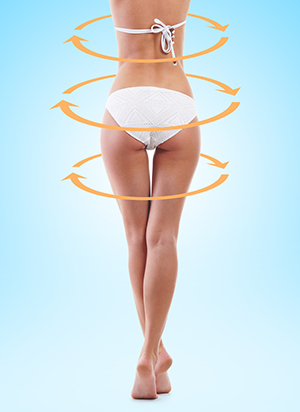Goodbye to Cellulite and Baldness!
What cellulite is for women, the bald patch is for men: not simply a ‘cosmetic problem’ but a tactic employed by the body to ensure our survival. By eliminating the causes of these two common complaints, we can help the skin regain its firmness and the head hold on to its crowning glory.

Not just beautiful, but healthy too: balanced bodies without too much acid won’t need to form cellulite.
It has always slightly surprised me that God should have bungled it when creating Woman. The fact that he created the head, upper body, arms, stomach and bottom to perfection, but evidently had a lapse in concentration when modelling the thigh and chose the wrong material. The sort of material that looks like corrugated cardboard and wobbles at every step—and that’s even before you’ve got to middle age.
As all the clever articles in medical and women’s magazines would have it, cellulite—also known as ‘orange peel’ or ‘cottage cheese’—is a God-given inevitability of female existence. In order for a child to grow, they say, female connective tissue must be extremely elastic—and the later consequence of this is cellulite. As if the womb were located in the thigh!
Nonetheless, God was fair when it came to delivering imperfection: while male legs are spared the curse of cellulite, there is a typically male problem that leaves the crown of creation gleaming in the sun—baldness. Something that we women—at least till now, thank God!—have escaped.
With all this in mind, why is it that baldness and cellulite are still a relatively unfamiliar sight in primitive peoples? Why do we seldom see bald heads in old pictures? (Admittedly the fashion of wearing wigs may have somewhat misrepresented this perspective.)
The answer is quite simple: men cannot get cellulite, so they get baldness instead. The cause of each rather unattractive phenomenon is not, in fact, due to a temporary blackout in the mind of our Creator, but in our eating habits. Both traits are ‘diseases of civilisation’ in which the word ‘civilisation’ stands for poor nutrition.
This is why neither hair tonics nor cellulite gels are truly effective. We can only regain a bushy head of hair and smooth legs from the inside. And if we change our diet the right way, we can get rid of bald heads and cellulite for good, not to mention varicose veins, spider veins and osteoporosis. Because all of them are linked to the same thing: a prolonged hyperacidity in our body.
More than Just Landfill
Let’s first take a look at a part of our body that gets little attention, but performs great services: connective tissue. A small advertising brochure entitled ‘Ganzheitliche Pharmazie’ (English: ‘Holistic Pharmacy’) explains it in marvellously simple terms: “Connective tissue is much more than just supporting or soft tissue. It is a functional organ found throughout the entire body. First and foremost it is a massive transport network. All nutrients, oxygen as well as medicine, for example, must be able to be conveyed without congestion.
“However, connective tissue is also your body’s rubbish dump since what you consume (including environmental toxins, nicotine and alcohol, food additives, etc.) is stored here first. If this tissue is overloaded, it can cause congestion and consequent disruptions to the entire system. Illness is caused when the normal function of connective tissue is disrupted and is not remedied over a long period of time.
“Connective tissue is also a kind of telephone network: fifty trillion cells in your body supply each other with information. A sick cell must be able to request a ‘repair team’; a cancer cell must, metaphorically speaking, be able to call for an ambulance. However, the flow of information in our body is only possible if this huge telecoms network is in optimal condition.”
Female connective tissue is somewhat more efficient than its male counterpart when it comes to absorbing metabolic waste products and storing them like a kind of rubbish bin. If we start dumping too many of these substances, i.e. acids, the tissue starts to thicken and the cells are not sufficiently supplied with nutrients and oxygen—or are not supplied at all. At this point, they react by producing increasing amounts of acidic metabolic waste—and the vicious circle starts afresh.
Am I Acidic?
We ‘civilised’ people give our connective tissue a rough ride. In fact, 80-90 per cent of the food and drink we supply our body is acid-forming, thanks to our denatured modern diet!
Too much acid can be fatal. The wrong food choices, stress, tension, noise pollution and feelings of fear and anxiety can contribute to considerable hyperacidity in the body. This modern sickness, also called ‘acidosis’, leads to a storage of crystallised acids in the blood vessels, muscles, joints, connective tissue and lymph vessels. Typical acidosis complaints are:
- Weakened regeneration capacity, susceptibility to infection;
- Chronic lack of drive, tiredness and feeling cold;
- Depressive and aggressive moods, restlessness;
- Sleep disruptions, weakness of concentration and memory;
- Sensitivity to pain, particularly teeth, to cold and acid;
- Caries, receding gums and tooth decay;
- Dull hair, grey hair and hair loss;
- Dry, wan skin, skin cracks, blemishes, eczema;
- Soft, brittle, split, grooved or thickened nails;
- Muscle cramps, sciatica and joint complaints;
- Rheumatic and arterial complaints, neuralgia;
- Irritation and burning in urinating, hyperacidic urine;
- Hyperacidic stomach, unpleasant sweating, bad breath;
- Digestive problems: constipation, diarrhoea, mushy stools, bloating;
- Increasing mucosity in the airways and sinuses;
- Too low blood pressure, fluctuating blood pressure, thyroid disruptions.
That said, the body needs a minimum amount of acid as this can be burned to supply energy. A healthy body excretes excess acid through the kidneys, blood, bowel, skin and by breathing, which all helps to maintain an acid-base balance with a slightly more alkaline pH value of 7.4. But if we continue eating too many acid-forming foods, the body will simply give up.
Our body’s own particular method of ‘rubbish collection’ is the lymph system, which can only be stimulated through exercise. Only then do muscles contract and stimulate their environment. “Thanks to this so-called muscle pump and corresponding flapping motion in the lymph vessels, the content is swept through in the right direction. Your lymph system is activated by exercise and sport (climbing the stairs, rapid walking, etc.)” writes Jacky Gehring in her excellent book Body Reset—No More Cellulite, Obesity or Hair Loss.
One of the best ways to activate the lymph system is trampolining. Lymph drainage also helps the body to transport waste out of the body; drinking plenty of water is a very important factor in this.
Most people drink much too little, which means that the body is not able to rid itself of waste effectively i.e. more toxins are stored in the cells and connective tissue. Given that a person loses one to one and a half litres of water through the skin every day without even exercising that much, s/he must drink at least two to three litres of still water daily to counterbalance it.
If we are acidotic, the body is forced to turn to our mineral stores for help. Says Jacky Gehring: “Trace elements and minerals (electrolytes) keep us healthy, efficient and looking good. They are involved in all metabolic processes: they keep our body firm, are important for producing energy, for nerve function, forming enzymes and for the immune system, among other things.” If a body remains acidotic over a long period of time, the body consumes large amounts of calcium, potassium, magnesium and iron in order to neutralise these acids (if our blood became too acidic, it would mean certain death). And where does the body get these minerals? From the skin, hair, nails, bones, cartilage, etc.
‘Acidic Hair’ Falls Out
Hair loss is not only a hormonal issue; in other words, the hormone balance also depends on the acid-base balance. Professional and personal stress, fear, irritation—all this leads to both a higher production of adrenalin and an increased acidic metabolic status. If you continue eating too many acidic foods, an alkaline deficiency will soon be the result.
A woman’s metabolism has one advantage in comparison to a man’s: it can temporarily ‘park’ excess acid in the placenta and connective tissue and then excrete it during the next period. In the permanently ‘acidic’ man, on the other hand, the effect is seen in his hair. Suffering an emergency situation, and to neutralise the acid that will otherwise at some point become life-threatening, the body robs the urgently-needed minerals from its biggest and most expendable store—the scalp. The hair roots no longer receive nutrients and the hair falls out. Jacky Gehring has some consolation for desperate men, however: “Hair roots (papilla) do not simply die off, as is often assumed. They simply wither and become inactive—but they’re still alive!”






